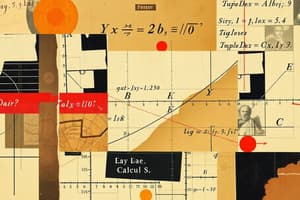Podcast
Questions and Answers
What is the focus of differential calculus?
What is the focus of differential calculus?
- Rates of change (correct)
- Accumulation of quantities
- Finding limits
- Area under the curve
What does the derivative at a point represent?
What does the derivative at a point represent?
- The area under the curve
- The average value of a function
- The maximum value of a function
- The instantaneous rate of change (correct)
What is the fundamental theorem of calculus about?
What is the fundamental theorem of calculus about?
- It states that derivatives are always negative
- It provides a method for calculating limits
- It links differential calculus and integral calculus (correct)
- It relates derivatives to one-sided limits
What does an integral represent?
What does an integral represent?
What type of integral provides the numerical value of the area under the curve between two limits?
What type of integral provides the numerical value of the area under the curve between two limits?
What is a common application of derivatives?
What is a common application of derivatives?
What does the concept of limit involve?
What does the concept of limit involve?
Which of the following techniques is used to calculate derivatives?
Which of the following techniques is used to calculate derivatives?
Flashcards
Calculus
Calculus
A branch of mathematics focused on continuous change, dealing with concepts like limits, derivatives, and integrals.
Derivative
Derivative
The instantaneous rate of change of a function at a point. Geometrically, it's the slope of the tangent line at that point.
Differential Calculus
Differential Calculus
The study of rates of change and slopes of tangent lines to curves.
Integral Calculus
Integral Calculus
Signup and view all the flashcards
Limit
Limit
Signup and view all the flashcards
Definite Integral
Definite Integral
Signup and view all the flashcards
Indefinite Integral
Indefinite Integral
Signup and view all the flashcards
Chain Rule
Chain Rule
Signup and view all the flashcards
Study Notes
Introduction to Calculus
- Calculus is a branch of mathematics focused on continuous change.
- It deals with concepts of limits, derivatives, and integrals.
- Two main branches: differential calculus and integral calculus.
Differential Calculus
- Focuses on rates of change.
- Key concept: derivative.
- The derivative of a function at a point represents the instantaneous rate of change of the function at that point.
- Geometrically, the derivative is the slope of the tangent line to the function at a given point.
- Fundamental Theorem of Calculus: Links differential and integral calculus.
- Techniques for calculating derivatives:
- Power rule: d(xn)/dx = nxn-1
- Product rule: d(uv)/dx = u dv/dx + v du/dx
- Quotient rule: d(u/v)/dx = (v du/dx - u dv/dx)/v2
- Chain rule: d(f(g(x)))/dx = f'(g(x)) * g'(x)
- Applications of Derivatives:
- Finding maximum and minimum values (critical points).
- Determining the concavity and points of inflection of a function.
- Solving optimization problems.
- Analyzing motion (velocity and acceleration).
Integral Calculus
- Focuses on accumulation of quantities.
- Key concept: integral.
- The integral of a function represents the area under the curve of the function over a given interval.
- Indefinite Integral: Represents the family of all antiderivatives of a function.
- Definite Integral: Gives the numerical value of the area under the curve between two limits.
- Fundamental Theorem of Calculus (Part 2): Integrals and derivatives are inverse operations.
- Techniques for evaluating integrals:
- Substitution method.
- Integration by parts.
- Partial fraction decomposition.
- Applications of Integrals:
- Calculating areas and volumes.
- Finding displacement and distance traveled.
- Solving problems related to rates of growth.
- Determining the average value of a function.
Limits
- Concept of Limit: The limit of a function as x approaches a certain value represents the value that the function approaches as x gets closer and closer to that value.
- Formal Definition: For a function f(x) to have a limit L as x approaches a, for any ε > 0, there exists a δ > 0 such that if 0 < |x-a| < δ, then |f(x) - L| < ε.
- One-sided Limits: Limits as x approaches a from the left or right.
- Rules of Limits: Algebraic operations with limits.
Functions
- Defining a Function: A relationship between a set of inputs (domain) and a set of outputs (range) where each input has exactly one output.
- Types of Functions: Polynomial, rational, exponential, logarithmic, trigonometric, etc.
- Important Properties of Functions: Continuous, differentiable, increasing, decreasing, etc.
- Graphing Functions: Understanding the shape of a function's graph provides insight into its behavior.
Notation
- Common Notation: Understanding the different symbols used for derivatives and integrals.
- f'(x) = derivative of f(x)
- f''(x) = second derivative of f(x)
- ∫f(x)dx = integral of f(x)
- ∫abf(x)dx = definite integral of f(x) from a to b
Studying That Suits You
Use AI to generate personalized quizzes and flashcards to suit your learning preferences.




